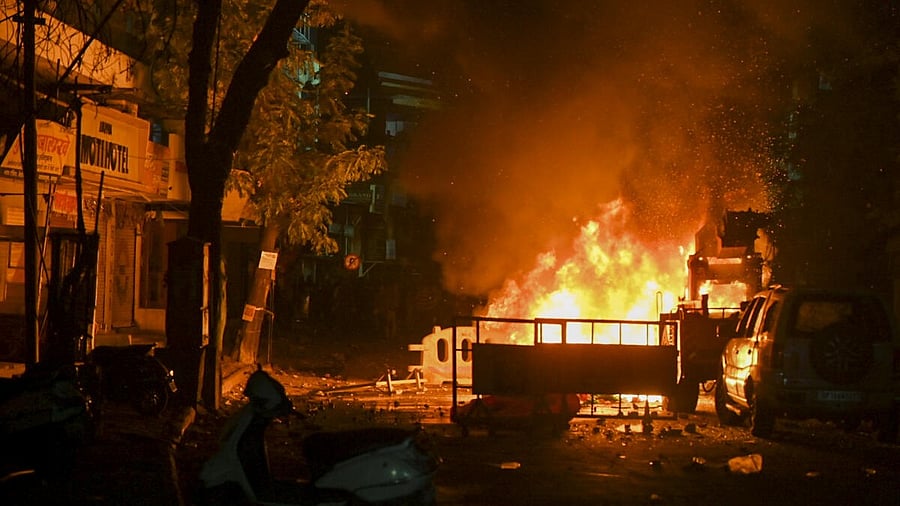
A fire set by miscreants amid violence following an agitation by a right-wing group demanding removal of Aurangzeb's tomb, in Nagpur
Credit: PTI Photo
Aurangzeb’s ghost is haunting Maharashtra. The premier state could be sitting on a tinderbox going by the way the demand for the demolition of the 17th-century Mughal emperor’s tomb has turned volatile.
The arson and clashes that took place in Nagpur on March 17 are indicative of how passions are being inflamed in the wake of controversial statements from those in the state Bharatiya Janata Party (BJP), including Cabinet Minister Nitesh Rane, seeking the razing of the tomb.
The Maharashtra Police have filed a case against some office-bearers of Vishwa Hindu Parishad (VHP) and Bajrang Dal for allegedly hurting religious sentiments during the protest in Nagpur.
The clashes that followed a march conducted by the VHP and the Bajrang Dal saw 33 policemen and five people injured. Authorities were taken by surprise by the sudden flareup, and Chief Minister Devendra Fadnavis, who also holds the home portfolio, has said that the violence appears premeditated.
Nagpur is no ordinary city. It is Fadnavis’ hometown. Fadnavis has emerged as the tallest leader in the state after the recent Assembly polls, where the BJP and its allies made mincemeat of the Opposition in the 288-member House. It is the home turf of Union minister Nitin Gadkari. It is also the headquarters of the Rashtriya Swayamsevak Sangh (RSS), which is celebrating its centenary this year. News reports suggest that Prime Minister Narendra Modi will be visiting the RSS headquarters on March 30.
Aurangabad, which was renamed Chhatrapati Sambhajinagar in 2022, is the headquarters of the backward Marathwada region, which was once part of the Nizam state. The city has a sizable Muslim population, and the minority community is there in almost all the districts of the region, which borders Telangana.
The violence in Nagpur is a matter of concern at a time when Maharashtra is passing through growing communal tensions flared up by almost uninterrupted statements of political leaders at a time when we need communal harmony and development.
Maharashtra has been witnessing a growing economic crisis. Despite being the most industrialised and urbanised state, it also has the dubious distinction of seeing a large number of farmer suicides due to agrarian distress. Mumbai might be the city housing the largest number of billionaires in India, but it hides some stark realities, including widening economic disparities. Unemployment in the state was at 15% in 2022, and the fact that the Ladki Bahini Yojana (promising Rs 1,500 to women from the weaker sections of society) becoming a trump card of the ruling alliance shows the depth of this crisis.
The BJP, the Sangh parivar, and Eknath Shinde's Shiv Sena are on the same page demanding the removal of the tomb. Fadnavis has said that it is unfortunate that the State has to provide protection to the tomb.
‘Stop hatred, promote peace’ is the Opposition’s demand. However, the tragedy is that the Opposition lacks the conviction, articulation, and strength to confront the Maha Yuti. The Maha Vikas Aghadi (MVA), comprising the Congress, Sharad Pawar’s NCP, and Uddhav Thackeray’s Shiv Sena, is yet to recover from the Assembly election result shock.
The spread of communal hatred and violence in Nagpur has got many thinking about how the chief minister was unaware of what’s been happening in his backyard.
Law and order in Maharashtra is not a thing to write home about. Cabinet minister Dhananjay Munde, belonging to Ajit Pawar’s NCP, was forced following the chilling murder of a sarpanch in Beed district allegedly by his close aide. Parbhani had also witnessed trouble in the wake of damaging a replica of the Constitution held by the statue of B R Ambedkar. Both Beed and Parbhani are part of the Marathwada region.
There looks a method in the madness over the campaign to raze Aurangzeb’s tomb. If the Babri masjid issue in Ayodhya brought the BJP to power at the Centre and the Hindi heartland, Aurangzeb's tomb could saffronise the entire Maharashtra.
Maharashtra, the second largest state after Uttar Pradesh, has emerged as a key state for the BJP. Despite being hailed as a progressive state, Maharashtra has several pockets that are communally sensitive. They include Bhiwandi, Malegaon, Chatrapati Sambhajinagar, and the entire Marathwada region.
It is still unclear whether the growing communal tension is a diversionary tactic to shift the people's attention from the real issues affecting their day-to-day lives or a well-planned strategy of strengthening the Hindutva vote-bank, which can further weaken the MVA.
The growing presence of the VHP, and the Bajrang Dal, in the state is a development which needs to be closely monitored.
The latest reports that normalcy has returned to Nagpur are encouraging, but the State needs to take extra care to ensure that the communal embers are not further fanned.
(Sunil Gatade and Venkatesh Kesari are senior journalists.)
Disclaimer: The views expressed above are the author's own. They do not necessarily reflect the views of DH.